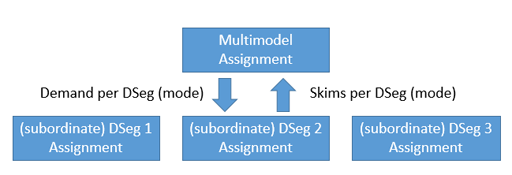During multimodal assignment, demand is assigned to a network whose overall paths consist of individual paths from an origin zone to a destination zone. Different modes (PrT, PuT) can be used on these paths. Mode change happens within a zone, so that the individual paths of the overall path then represent origin-destination relations. For example, a people-based demand model can be used to calculate a demand matrix for air traffic. Typically, supply does not exist between all zones of a model, so that different modes are used on the path to the departure airport and on the path from the arrival airport. Possible path sequences, i.e. the sequence of paths between zones, are determined through the search of multimodal assignment, during which the demand is distributed based on a logit model.
Multimodal assignment is closely linked to the impact models of PrT and PuT. Illustration 173 illustrates how they are connected.

Illustration 173: Connection between multimodal assignment and impact models of PrT and PuT
Skims are calculated based on the assignment of subordinate demand segments. These skims form the basis for determining the impedance on paths that can be part of path sequences. Multimodal assignment generates path sequences with volumes. The exact course of these paths in the network can be calculated through assignment of the respective subordinate demand segments.
In the context of multimodal assignment, paths are often mentioned that are covered with different modes. As shown in Illustration 173, it is actually the demand segments that are assigned to a mode of the type PrT or PuT. For a demand segment assigned during multimodal assignment, the allocation to a mode is merely a technical matter.
The prerequisites for demand assignment using multimodal assignment can be summarized as follows:
- Demand matrices for (superordinate) demand segments that are only technically allocated to a mode must be available. The allocation to a subordinate demand segment (and mode) that corresponds to the main mode is performed by selecting an obligatory (subordinate) demand segment in the procedure dialog of multimodel assignment.
- Demand matrices for the subordinate demand segments must exist. Under Demand data, they must be assigned to the respective demand segments. These demand matrices must not be formula matrices.
- Skim matrices for subordinate demand segments must exist and contain calculated data. Which skims are used for the impedance calculation of the multimodal assignment results from the definition of the skims (Using Visum: Setting metadata for skim matrices) and the coefficients for the individual components (Using Visum: Parameters of Multimodal assignment).
The result of a multi-modal assignment can be described as follows:
- Path sequences are created that may consist of multiple paths. These paths can be used by different modes - represented by the subordinate demand segments assigned to a mode. This means the path sequences created as a result of the assignment represent complete trips from an origin to a destination, regardless of whether the modes used change.
- The path sequences have a volume.
- The (subordinate) demand segments used on the individual paths are known. The course of these paths within the network is only known if the respective demand segment has been assigned to the network. The paths of this demand segment are used according to their shares in the assignment, whereas the OD relation may be included in multiple path sequences.
|
Note: In the directory C:\Users\Public\Documents\PTV Vision\PTV Visum 2025/Examples, you can find an example of use on this topic. The Multimodal Assignment example describes a use case of multimodal assignment. |

